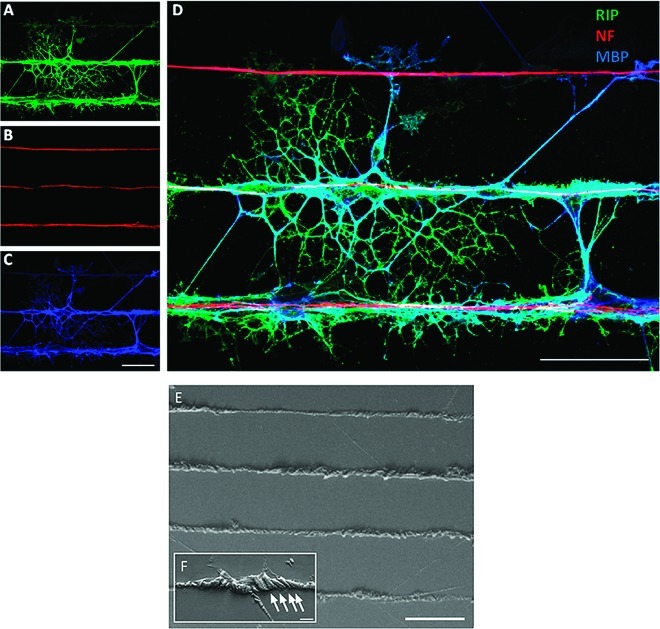Abstract
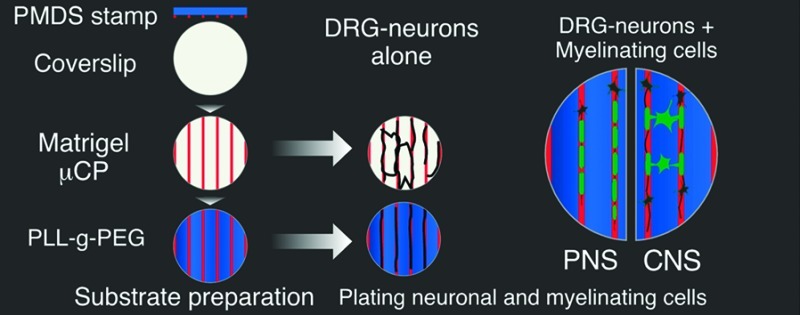
Myelination is a highly regulated developmental process whereby oligodendrocytes in the central nervous system and Schwann cells in the peripheral nervous system ensheathe axons with a multilayered concentric membrane. Axonal myelination increases the velocity of nerve impulse propagation. In this work, we present a novel in vitro system for coculturing primary dorsal root ganglia neurons along with myelinating cells on a highly restrictive and micropatterned substrate. In this new coculture system, neurons survive for several weeks, extending long axons on defined Matrigel tracks. On these axons, myelinating cells can achieve robust myelination, as demonstrated by the distribution of compact myelin and nodal markers. Under these conditions, neurites and associated myelinating cells are easily accessible for studies on the mechanisms of myelin formation and on the effects of axonal damage on the myelin sheath.
Keywords: Myelination, in vitro cell culture system, micropatterning, Schwann cells, oligodendrocytes, dorsal root ganglia neurons
Myelin is a specialized membranous structure generated by two different types of glial cells in the vertebrate nervous system.1 Oligodendrocytes in the central nervous system (CNS) and Schwann cells in the peripheral nervous system (PNS) produce and extend plasma membrane processes that spirally enwrap the axon and form myelinated segments (internodes) separated by intervals known as nodes of Ranvier. Myelin functions as an insulator that increases the velocity of electrical signals transmitted along an axon through a process known as saltatory conduction (from Latin: saltare meaning “to jump”). This occurs because myelinated internodes allow electrical charges to pass through the axon from one electrically active area (node of Ranvier) to the next without dissipating.2−4 Myelin sheath destruction results in severe motor and sensory deficits, as seen in patients with de- and dysmyelinating diseases such as multiple sclerosis, Guillain-Barré syndrome, and Charcot-Marie-Tooth disease.5 Although the myelinating cells of the CNS and PNS have long been identified, the process by which these cells acquire their extraordinary morphology and myelinate the axons as well as the mechanisms by which myelin degenerates in disease states remain elusive.3 In this regard, establishing reliable in vitro myelination systems has been crucial for studying the mechanisms underlying myelin formation and degeneration. Much of what we already know about the characteristics and potentialities of Schwann cells and oligodendrocytes has come from cell culture models of differentiation and myelination.6−8 Although these in vitro systems have revolutionized our understanding of the molecular and biochemical changes accompanying myelin formation,9−11 they have been limited by poor experimental control of the microenvironment and the lack of precise manipulation of single cells. A cell culture system that facilitates the visualization and manipulation of myelin in vitro is needed to overcome these limitations.
Microfabrication provides a useful and promising technology for the design and control at micrometer scale of cellular microenvironments including substrate topology and biochemical composition, cell types surrounding the cells of interest, and medium composition.12,13 Among the numerous available methods to make chemically structured surfaces, microcontact printing (μCP) is a simple, cost-effective, and versatile technique that results in micrometer-sized patterns on surfaces that can be used for cell culture.14,15 As described in Figure 1, μCP requires a stamp with a relief of the features to be printed. Such stamps are cast by polymerizing polydimethylsiloxane (PDMS) on top of microstructured molds, previously generated by soft-lithography on silicon wafers coated with a photosensitive matrix (photoresist). Once PDMS polymerizes as a negative stamp of the pattern, it is peeled from the mold and inked with the protein of interest. Stamps are then pressed upon coverslips or plastic Petri dishes, effectively printing the pattern on the surface (Figure 1). Microcontact printing has been used to grow different types of neurons including cortical neurons,16 hippocampal neurons,12,17 DRG neurons,18 and motoneurons.19
Figure 1.
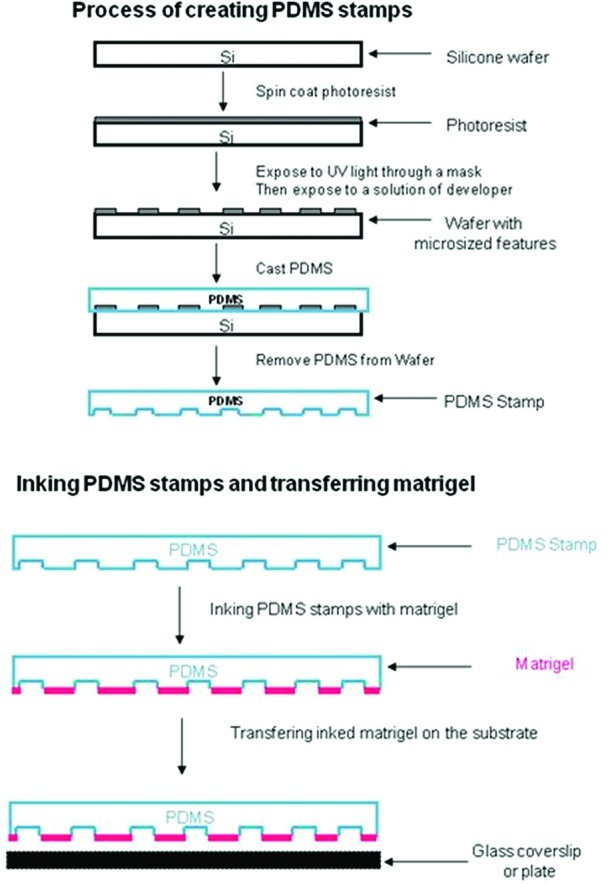
Coverslip micropatterning with Matrigel through microcontact printing. Schematic representation of the microcontact printing procedure. Soft lithography imprinting of a photoresist coated silicon wafer produces a mold with microsized features. Liquid PDMS is cast to the mold and allowed to polymerize to form a negative-patterned stamp. After peeling the silicon stamp from the master, matrigel is applied as ink and transferred to a substrate by contact printing.
In the present work, microcontact printing has been used to develop a reliable method for growing long-term myelinating cultures on a restricted and organized substrate. To do so, we first optimized conditions that would allow adherence and growth of DRG neurons in the absence of accompanying myelinating cells. We required a stamping solution substrate that could promote the growth, survival, and differentiation of the primary cell cultures and maintain the cultures for the long periods of time required for in vitro myelination. Polylysines (PDL or PLL) are positively charged synthetic molecules widely used as substrates to enhance neuronal adhesion,20 and have been used in μCP to align neurons in vitro.21−23 However, we chose to use Matrigel, an extract of basement membrane proteins and growth factors secreted by Engelbreth-Holm-Swarm (EHS) mouse sarcoma cells, because it is a better substrate for the myelinating coculture system.24 Matrigel has been shown to be highly effective in promoting cell growth and axon extension of DRG derived neurons while concomitantly supporting Schwann cell proliferation and differentiation over extended periods of time.24 In addition, Matrigel has been successfully used to micropattern substrates for epithelial cells25 and human embryonic stem cells.23
To test DRG neuron behavior on the micropatterned surface, dissociated DRG cell suspensions were treated with fluorodeoxyuridine (FdU) to halt the proliferation of dividing cells (i.e., Schwann cells and fibroblasts) and seeded onto coverslips pretreated with Matrigel in three different configurations: (A) whole surface uniformly coated with Matrigel (nonmicropatterned), (B) micropatterned 10 μm Matrigel lines separated by 110 μm nontreated areas, and (C) 10 μm Matrigel lines with a pitch of 120 μm, where the nonprinted areas were secondarily modified into surfaces highly restrictive to cell attachment and growth by poly-l-lysine-grafted poly(Ethylene Glycol) (PLL-g-PEG) adsorption. PLL-g-PEG is a graft copolymer whose polycationic backbone adsorbs electrostatically on negatively charged surfaces (such as glass), rendering the treated surfaces resistant to protein and cell adsorption.26 Cells were allowed to grow and differentiate over a relatively short period of time (7 days), after which cultures were fixed and stained to visualize nuclei with Topro-3 as well as cell bodies and extending processes with neurofilament immunostaining.
DRG neurons grown on coverslips uniformly coated with Matrigel extended processes that covered the entire surface with association and fasciculation of the axons forming bundlelike networks that projected over relatively long distances (Figure 2A). As expected, these cells attached haphazardly to the substrate and did not display any apparent orientation.
Figure 2.

7 DIV dorsal root ganglia neurons and their processes align along 10 μm matrigel lines. DRG neurons pretreated with FdU to eliminate dividing cells seeded on coverslips. (A) Uniformly coated with Matrigel; (B) micropatterned 10 μm wide Matrigel lines; (C) micropatterned 10 μm Matrigel lines separated by 110 μm strips of PLL-g-PEG. Cells were fixed and stained for neurofilament-H (red), an axonal marker, and nuclei (blue, Topro-3). Scale bar is 50 μm.
Dissociated DRG suspensions cultured on 10 μm wide Matrigel lines (Figure 2B) had a much different pattern. While the cell bodies were still homogeneously distributed with no difference in cell density between the Matrigel lines and the untreated regions, neurites preferentially associated and extended in parallel to the Matrigel micropattern lines. We observed that many processes crossed from one line to the next and continued to extend in the orientation of their new track (Figure 2B). Note that these Matrigel lines are considerably narrower and more effective than previously described μCP laminin tracks which required a width of at least 30 μm to achieve axonal directionality.27
To determine if narrow lines of Matrigel alone are sufficient for neurite extension and if neurites could be restricted to the micropatterned lines, DRG cells were plated on the highly restrictive micropatterned substrates (10 μm Matrigel lines separated by 110 μm nonadhesive PLL-g-PEG strips). An overall decrease in cell number (Figure 2C) was observed when compared to the previous track configuration (Figure 2B). The double nature of this surface patterning confined both cell bodies and axons to the Matrigel coated lines. Cell attachment outside of Matrigel lines or connecting from one track to another was rare, reflecting a lack of cell adhesion in the PLL-g-PEG covered areas.
Considering this promising data, we then investigated if DRG-derived neurites growing on highly restrictive substrates could reproduce the two myelination paradigms that comprise myelin research: CNS myelination by oligodendrocytes and PNS myelination by Schwann cells.
To model CNS myelination in vitro, we added exogenous rat oligodendrocytes precursor cells (OPCs) to DRG neurons that had grown for 7 days on highly restrictive micropatterned substrates. Cocultures were fixed and stained after a further 7 days. Under these conditions, OPCs lose their bipolar morphology, acquire the characteristic multiple-process geometry of mature oligodendrocytes, and express late differentiation markers: RIP and MBP (ref (28); Figure 3). We observed that these cells were capable of engaging and enwrapping (Figure 3) multiple axons from two or more different Matrigel lines, in spite of the nonpermissive PLL-g-PEG areas (Figure 3, arrows). This distribution is highly reminiscent of the in vivo organization of white matter tracks, where each oligodendrocyte myelinates multiple axons and gives rise to many internodes. While it was not possible to confirm the presence of axon-surrounding structures that represent mature compact myelin by immunoflorescence microscopy, we did observed by scanning electron microscopy a substantial amount of plasma membrane that appeared to wrap around the neurites (Figure 3E and F).
Figure 3.
Oligodendrocytes associate with multiple axons from different permissive Matrigel lines and engage and extend membranes on DRG neuron processes. DRG-neurons were seeded on the highly restrictive micropatterned coverslips in the presence of FdU to eliminate dividing cells. After 7 DIV, cortically derived OPCs were added to the cell culture. Seven days after coculture, cells were fixed. In panels (A–D), cells were stained to reveal oligodendrocytes with an oligodendroglial specific marker (RIP in green, MBP in blue) and DRG neurons with neurofilament (red). Scale bar is 100 μm. In panels (E) and (F), cells were observed via a JSM-6460LV scanning electron microscope. Scale bars are 100 μm (E) and 10 μm (F).
To investigate PNS myelination on our patterned substrates, we withheld the FdU treatment from dissociated DRG cell cultures, thus keeping the endogenous Schwann cells alive and dividing.24 After 7 days in vitro, PNS cocultures were fixed and stained with an antibody recognizing α-tubulin which is present in DRG neurons and Schwann cells, an antibody recognizing neurofilament, a specific marker for DRG processes, and Topro-3, a marker that stains the nuclei of both DRG neurons and Schwann cells. When plated on the highly restrictive μCP surface, both the neuronal cells and the accompanying non-neuronal cells were restricted to the Matrigel lines (Figure 4) with all cell nuclei showing a flattened morphology (Figure 4C) likely due to limited surface being available for the attachment on the thin Matrigel lines. Tubulin staining of the cells shows two distinct patterns: fine continuous filament staining along axons and diffuse staining in nuclei-associated areas, similar to the noncompacted cytoplasmic Schwann cell soma areas that line PNS myelin (Figure 4A). Therefore, axon juxtaposed cells in Matrigel confined lines presented multiple characteristics reminiscent of myelinating Schwann cells.
Figure 4.
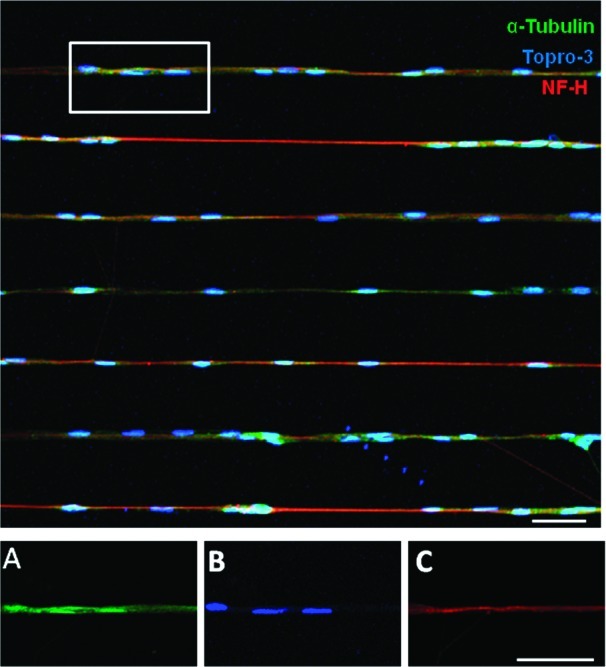
Dorsal root ganglia neurons and Schwann cells are restricted to Matrigel micropatterns after 7 days of in vitro culture. DRG-derived cells (neurons and Schwann cells) seeded on the highly restrictive micropatterned coverslips and maintained for 7 days. Cultures were fixed and stained to reveal (A) α-tubulin subunit present in both cultured cells types Schwann cells and DRG neurons (green), (B) axonal neurofilament-H (red), and (C) nuclei (Topro-3; blue). Scale bar is 50 μm.
Having demonstrated that neurons and Schwann cells can be cocultured on micropatterned Matrigel lines, we now stimulated the myelination program by supplementing the culture media with 20 μM ascorbic acid for 6 weeks, the standard protocol for in vitro studies of myelin deposition.6 Under these conditions, Schwann cells engaged and wrapped axons with each Schwann cell enwrapping a single axon. Axons showed intermittent ensheathment by smooth tubular structures, consistent with fully myelinated internodes. These periodic structures were highly enriched in MBP (Figure 5A and B), which in the PNS is only present in terminally differentiated Schwann cells.29 Axonal organization was consistent with establishment of fully myelinated segments, as was shown by the distribution of CASPR (Figure 5C), an axonal protein that strictly localizes to the paranodal regions that flank the nodes of Ranvier.29
Figure 5.
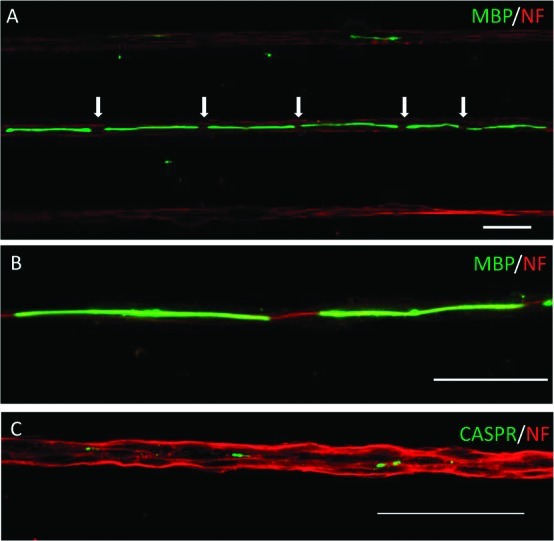
Dorsal root ganglia axons confined to micropatterns become fully myelinated, forming nodes of Ranvier. Long-term behavior of typical myelinating DRG neurons and Schwann cells growing on the highly restrictive micropatterned coverslips. Myelination by the Schwann cells was stimulated by ascorbic acid. After 6 weeks in vitro, cells were fixed and stained to reveal markers for compact myelin (MBP, green; A and B), nodes of Ranvier (CASPR, an axonal marker of paranodal areas, green, (C) and axons of DRG neurons (neurofilament-H in red, A, B, C). Scale bar is 50 μm.
In conclusion, we report a new model system for studying CNS and PNS myelination in vitro in a highly structured manner. The method describes how to make thin (10 μm) substrate lines with a pitch of 120 μm, where the nonprinted areas are backfilled with PLL-g-PEG. Onto these surfaces we plated rat dorsal root ganglia derived sensory neuron in the presence or absence of myelinating cells: OPCs as a CNS culture system or Schwann cells as a PNS culture system. Our data shows that, at 7 days after plating, neurons have extended long neurites along the micropatterned tracks and this can be maintained several weeks in culture. Meanwhile, myelinating cells in these cultures were healthy and associated with axons. Both the CNS and PNS culture systems showed evidence of myelination, although this was more complete in the PNS system as shown by the presence of compact myelin and formation of internodes. Indeed, after several weeks in vitro, Schwann cells organized into classical internodes inducing the formation of functional subdomains along axons. To our knowledge, this is the first report of coculture between myelinating cells and axons in a structured surface platform that has achieved myelination. It is important to stress that the coculture system requires a long time in culture to achieve full myelination; therefore, it is notable that the micropatterned substrates resisted 6 weeks of culture while allowing neuron and Schwann cell maintenance, axon directionality, and in vitro myelination. Such long-term cell culture conditions have not been previously described for μCP.
A major advantage of our system is that the μCP is done on top of glass coverslips; therefore, it can readily be adapted to glass-bottom cell-culture dishes, which, in conjunction with inverted microscopy, permit live-cell imaging. In this context, the limited number of axons and myelinating cells in each Matrigel line would facilitate the characterization of morphological and biomechanical events that occur both during axonal ensheathment and myelin compaction. Such a live-cell setup will permit the study of axon–myelin interactions and responses to localized damage by laser light ablation or to the addition of immune cells, therefore modeling the events surrounding nerve damage and autoimmune diseases. Likewise, these conditions are likely to prove ideal for research on isolated neurons with oriented axons, a necessary model in the study of the cellular and molecular pathways that underlie the peripheral neuropathies caused by multiples stressors (diabetes, human immunodeficiency virus, or toxicity from chemotherapy treatment).30 Finally, the coupling of this platform to localized delivery by microfluidic probes31,32 will permit a live-cell based assay for the evaluation of axon and/or myelin protecting or myelination enhancing drugs.
Materials and Methods
Silicon Wafer Fabrication
Polished 4 in. silicon wafers were spin-coated with SU-8 2015 resist (Microchem Corp., Newton, MA) to a nominal thickness of 15 μm and soft-baked on a hot plate at 95 °C for 3 min to drive out the solvent. The coated wafers were exposed to ∼130 mJ/cm2 white light (long-pass filtered with a cutoff at 350 nm) in a contact aligner (EVG 620) and postbaked on a hot plate at 95 °C for 4 min. The exposed wafer was developed by immersion in SU-8 developer (Microchem Corp.) for 3 min and finally rinsed with isopropyl alcohol and air-dried. A hard bake step at 150 °C for 1 min removed surface cracks.
PDMS Production and Matrigel Printing
Polydimethylsiloxane (PDMS, Sylgard 184, Dow Corning, Midland, MI) and the curing agent were combined at a ratio of 10:1, mixed thoroughly and degassed under vacuum. The PDMS mixture was poured over the relief master wafer. The PDMS was then allowed to polymerize in the oven for 24 h at 60 °C. The cured PDMS layer was then gently peeled off. The stamps were cleaned in ethanol 70% then cut in 1 cm2 squares and incubated with Matrigel (BD Biosciences, Mississauga, ON) diluted 1:10 in L15 medium (Invitrogen, Burlington, ON) at 4 °C overnight. The next day, the stamps were washed twice with L-15, nitrogen dried, and used to microcontact print Petri dishes and/or plasma treated coverslips. Oxygen plasma treatment was done to enhance the hydrophilicity of glass, which increases the adherence of Matrigel.
Passivation with Poly-l-lysine-Grafted Poly(ethylene glycol) (PLL-g-PEG) Backfilling
PLL (20 kDa)-g-(3.5)-PEG (2 kDa) (Susos AG, Switzerland) is a graft polymer with a 20 kDa PLL backbone with 2 kDa PEG side chains and a grafting ratio of 3.5 (mean PLL monomer units per PEG side chain). PLL-g-PEG was used to backfill the nonprinted regions. This reagent has been previously shown to be highly resistant to the attachment of single proteins, serum, and plasma components.26,33
Animals
Sprague–Dawley rats were obtained from Charles River Canada (Saint-Constant, QC). All procedures were performed in accordance with the Canadian Council on Animal Care guidelines for the use of animals in research.
Cell Culture
Rat Dorsal Root Ganglia Cells
The procedure used for dissection and cell culture has been described previously.24 In brief, DRGs were dissected from rat E15–16 embryos and, after digestion with 0.25% trypsin, mechanically dissociated with a plastic Pasteur pipet. The resulting cells were plated on the previously described substrates at approximately 0.5 × 105 cells/mL in Neurobasal media containing 2% B27, 0.3% l-glutamine (Invitrogen), and 75 ng/mL nerve growth factor (NGF; Roche, Laval, QC). At 2–3 days after plating, 50 μg/mL ascorbic acid (Sigma-Aldrich Canada, Oakville, ON) was added to the PNS cell culture media.
Rat Oligodendrocyte Culture
OPCs were obtained from mixed glial cultures derived from newborn rat cerebral cortices, as described previously.34 Briefly, after plating cerebral cortex cultures in Dulbecco’s modified Eagle’s medium (DMEM; Invitrogen) with 10% fetal bovine serum and 1% penicillin–streptomycin (Invitrogen) on poly-d-lysine-coated flasks for 7–10 days, OPCs were separated by agitation at 220 rpm for 1 h to remove microglial cells and overnight to lift off OPCs. The OPCs were further purified by differential adhesion to uncoated Petri dishes, resuspended in Sato medium (DMEM, 5 μg/mL human transferrin, 10 μg/mL insulin, 100 μM putrescine, 200 nM progesterone, 500 pM tri-iodo-thyronine, 220 nM selenium, 520 nM l-thyroxine, and 1% penicillin/streptomycin) and plated on the neuronal cultures and cultured in 1:1 Neurobasal-Sato media.
Immunofluorescence
Cells were fixed in 4% paraformaldehyde in PBS and permeabilized with 0.2% Triton X-100 in PBS. Primary antibodies were used to detect α-tubulin (DSHB; 1:100), neurofilament-H (Aves Laboratories; 1:1000), myelin basic protein (1:1000), and CASPR (NeuroMab; Davis, CA; 1:75). The following secondary antibodies (Jackson ImmunoResearch; Mississauga, ON) were used: fluorescein-conjugated donkey anti-mouse (1:1000), fluorescein-conjugated donkey anti-rabbit (1:1000), and rhodamine-conjugated goat anti-chicken (1:500). The Topro-3 marker (Invitrogen; 1:1000) was used to stain nuclei. All incubations were in 5% bovine serum albumin in PBS overnight at 4 °C with PBS washes between steps. Coverslips were mounted in Aqua-Poly/Mount (Polysciences Inc., Warrington, PA) and visualized with a Fluoview (FV1000) Olympus confocal microscope.
Scanning Electron Microscopy (SEM)
Cells cultured on coverslips were fixed in 4% paraformaldehyde, washed twice with PBS, post fixed with OsO4, and washed twice in PBS followed by water. They were then gently removed from their wells, mounted on a stub with carbon tape, and examined wet using a JEOL variable pressure scanning electron microscope JSM-6460LV at around 50 Pa and a voltage of 10 kV.
Acknowledgments
This work is dedicated to the memory of our mentor Dr. David R. Colman, a great supporter, an inspiring leader, and out-of-the-box thinker. The authors would like to thank Drs. Rob Dunn, Ajit Singh Dhaunchak, and Liliana Pedraza for critical reading of the manuscript, Ms. Wiam Belkaid and Dr. Ziwei Li for providing DRG neurons in the early stages of this project, and Ms. Sylvia Francis Zalzal from the laboratory of Calcified tissues and biomaterials at Université de Montréal for technical assistance with SEM imaging. We would also like to acknowledge the editorial assistance of Drs. Madeline Pool and Patricia Yam.
Author Contributions
D.L. and D.R.C. designed the experiments. P.T. produced the silicon wafer. D.L. performed the experiments. D.L., A.D.R., and D.R.C. analyzed the experimental results. D.L. and A.D.R. wrote the manuscript.
This work is supported by Grant No. RMF-7028 from the Regenerative Medicine and Nanomedicine Initiative of the Canadian Institutes of Health Research (CIHR) to D.R.C. and by FONDECYT (No. 1080252) to A.D.R. The McGill Program in Neuroengineering is supported by CIHR, the Ministry of Industry of Canada, Rio Tinto Alcan and by The Molson Foundation.
The authors declare no competing financial interest.
Author Status
⊥ Deceased June 1, 2011.
Author Present Address
∥ Interdisciplinary Nanoscience Center, Aarhus University, Denmark.
References
- Quarles R. H. (2002) Myelin sheaths: glycoproteins involved in their formation, maintenance and degeneration. Cell. Mol. Life Sci. 59, 1851–1871. [DOI] [PMC free article] [PubMed] [Google Scholar]
- Hartline D. K.; Colman D. R. (2007) Rapid conduction and the evolution of giant axons and myelinated fibers. Curr. Biol. 17, R29–35. [DOI] [PubMed] [Google Scholar]
- Nave K. A.; Trapp B. D. (2008) Axon-glial signaling and the glial support of axon function. Annu. Rev. Neurosci. 31, 535–561. [DOI] [PubMed] [Google Scholar]
- Taveggia C.; Feltri M. L.; Wrabetz L. (2010) Signals to promote myelin formation and repair. Nat. Rev. Neurol. 6, 276–287. [DOI] [PMC free article] [PubMed] [Google Scholar]
- Porter B. E.; Tennekoon G. (2000) Myelin and disorders that affect the formation and maintenance of this sheath. Ment. Retard. Dev. Disabil. Res. Rev. 6, 47–58. [DOI] [PubMed] [Google Scholar]
- Eldridge C. F.; Bunge M. B.; Bunge R. P.; Wood P. M. (1987) Differentiation of axon-related Schwann cells in vitro. I. Ascorbic acid regulates basal lamina assembly and myelin formation. J. Cell Biol. 105, 1023–1034. [DOI] [PMC free article] [PubMed] [Google Scholar]
- Gao F. B.; Durand B.; Raff M. (1997) Oligodendrocyte precursor cells count time but not cell divisions before differentiation. Curr. Biol. 7, 152–155. [DOI] [PubMed] [Google Scholar]
- Jarjour A. A.; Zhang H.; Bauer N.; Ffrench-Constant C.; Williams A. (2012) In vitro modeling of central nervous system myelination and remyelination. Glia 60, 1–12. [DOI] [PubMed] [Google Scholar]
- Kondo T.; Raff M. (2000) Oligodendrocyte precursor cells reprogrammed to become multipotential CNS stem cells. Science 289, 1754–1757. [DOI] [PubMed] [Google Scholar]
- Tang D. G.; Tokumoto Y. M.; Apperly J. A.; Lloyd A. C.; Raff M. C. (2001) Lack of replicative senescence in cultured rat oligodendrocyte precursor cells. Science 291, 868–871. [DOI] [PubMed] [Google Scholar]
- Watkins T. A.; Emery B.; Mulinyawe S.; Barres B. A. (2008) Distinct stages of myelination regulated by gamma-secretase and astrocytes in a rapidly myelinating CNS coculture system. Neuron 60, 555–569. [DOI] [PMC free article] [PubMed] [Google Scholar]
- Wheeler B. C.; Corey J. M.; Brewer G. J.; Branch D. W. (1999) Microcontact printing for precise control of nerve cell growth in culture. J. Biomech. Eng. 121, 73–78. [DOI] [PubMed] [Google Scholar]
- Weibel D. B.; Garstecki P.; Whitesides G. M. (2005) Combining microscience and neurobiology. Curr. Opin. Neurobiol. 15, 560–567. [DOI] [PubMed] [Google Scholar]
- Jackman R. J.; Wilbur J. L.; Whitesides G. M. (1995) Fabrication of submicrometer features on curved substrates by microcontact printing. Science 269, 664–666. [DOI] [PubMed] [Google Scholar]
- Shen K.; Qi J.; Kam L. C.. Microcontact printing of proteins for cell biology. J. Visualized Exp 2008, not supplied. [DOI] [PMC free article] [PubMed]
- Vogt A. K.; Lauer L.; Knoll W.; Offenhausser A. (2003) Micropatterned substrates for the growth of functional neuronal networks of defined geometry. Biotechnol. Prog. 19, 1562–1568. [DOI] [PubMed] [Google Scholar]
- Lucido A. L.; Suarez Sanchez F.; Thostrup P.; Kwiatkowski A. V.; Leal-Ortiz S.; Gopalakrishnan G.; Liazoghli D.; Belkaid W.; Lennox R. B.; Grutter P.; Garner C. C.; Colman D. R. (2009) Rapid assembly of functional presynaptic boutons triggered by adhesive contacts. J. Neurosci. 29, 12449–12466. [DOI] [PMC free article] [PubMed] [Google Scholar]
- Hodgkinson G. N.; Tresco P. A.; Hlady V. (2007) The differential influence of colocalized and segregated dual protein signals on neurite outgrowth on surfaces. Biomaterials 28, 2590–2602. [DOI] [PMC free article] [PubMed] [Google Scholar]
- Shi P.; Nedelec S.; Wichterle H.; Kam L. C. (2010) Combined microfluidics/protein patterning platform for pharmacological interrogation of axon pathfinding. Lab Chip 10, 1005–1010. [DOI] [PMC free article] [PubMed] [Google Scholar]
- Banker G.; Goslin K. (1988) Developments in neuronal cell culture. Nature 336, 185–186. [DOI] [PubMed] [Google Scholar]
- Chang J. C.; Brewer G. J.; Wheeler B. C. (2003) A modified microstamping technique enhances polylysine transfer and neuronal cell patterning. Biomaterials 24, 2863–2870. [DOI] [PubMed] [Google Scholar]
- James C. D.; Davis R.; Meyer M.; Turner A.; Turner S.; Withers G.; Kam L.; Banker G.; Craighead H.; Isaacson M.; Turner J.; Shain W. (2000) Aligned microcontact printing of micrometer-scale poly-L-lysine structures for controlled growth of cultured neurons on planar microelectrode arrays. IEEE Trans. Bio-Med. Eng. 47, 17–21. [DOI] [PubMed] [Google Scholar]
- Lee L. H.; Peerani R.; Ungrin M.; Joshi C.; Kumacheva E.; Zandstra P. (2009) Micropatterning of human embryonic stem cells dissects the mesoderm and endoderm lineages. Stem Cell Res. 2, 155–162. [DOI] [PubMed] [Google Scholar]
- Fex Svenningsen A.; Shan W. S.; Colman D. R.; Pedraza L. (2003) Rapid method for culturing embryonic neuron-glial cell cocultures. J. Neurosci. Res. 72, 565–573. [DOI] [PubMed] [Google Scholar]
- Sodunke T. R.; Turner K. K.; Caldwell S. A.; McBride K. W.; Reginato M. J.; Noh H. M. (2007) Micropatterns of Matrigel for three-dimensional epithelial cultures. Biomaterials 28, 4006–4016. [DOI] [PubMed] [Google Scholar]
- Csucs G.; Michel R.; Lussi J. W.; Textor M.; Danuser G. (2003) Microcontact printing of novel co-polymers in combination with proteins for cell-biological applications. Biomaterials 24, 1713–1720. [DOI] [PubMed] [Google Scholar]
- Song M.; Uhrich K. E. (2007) Optimal micropattern dimensions enhance neurite outgrowth rates, lengths, and orientations. Ann. Biomed. Eng. 35, 1812–1820. [DOI] [PubMed] [Google Scholar]
- Baumann N.; Pham-Dinh D. (2001) Biology of oligodendrocyte and myelin in the mammalian central nervous system. Physiol. Rev. 81, 871–927. [DOI] [PubMed] [Google Scholar]
- Poliak S.; Peles E. (2003) The local differentiation of myelinated axons at nodes of Ranvier. Nat. Rev. Neurosci. 4, 968–980. [DOI] [PubMed] [Google Scholar]
- Melli G.; Hoke A. (2009) Dorsal Root Ganglia Sensory Neuronal Cultures: a tool for drug discovery for peripheral neuropathies. Expert Opin. Drug Discovery 4, 1035–1045. [DOI] [PMC free article] [PubMed] [Google Scholar]
- Perrault C. M., Qasaimeh M. A., Brastaviceanu T., Anderson K., Kabakibo Y., and Juncker D. (2010) Integrated microfluidic probe station. Rev. Sci. Instrum. 81, 115107. [DOI] [PubMed] [Google Scholar]
- Juncker D.; Schmid H.; Delamarche E. (2005) Multipurpose microfluidic probe. Nat. Mater. 4, 622–628. [DOI] [PubMed] [Google Scholar]
- Tosatti S.; De Paul S. M.; Askendal A.; VandeVondele S.; Hubbell J. A.; Tengvall P.; Textor M. (2003) Peptide functionalized poly(l-lysine)-g-poly(ethylene glycol) on titanium: resistance to protein adsorption in full heparinized human blood plasma. Biomaterials 24, 4949–4958. [DOI] [PubMed] [Google Scholar]
- Koller M. R.; Manchel I.; Maher R. J.; Goltry K. L.; Armstrong R. D.; Smith A. K. (1998) Clinical-scale human umbilical cord blood cell expansion in a novel automated perfusion culture system. Bone Marrow Transplant. 21, 653–663. [DOI] [PubMed] [Google Scholar]



